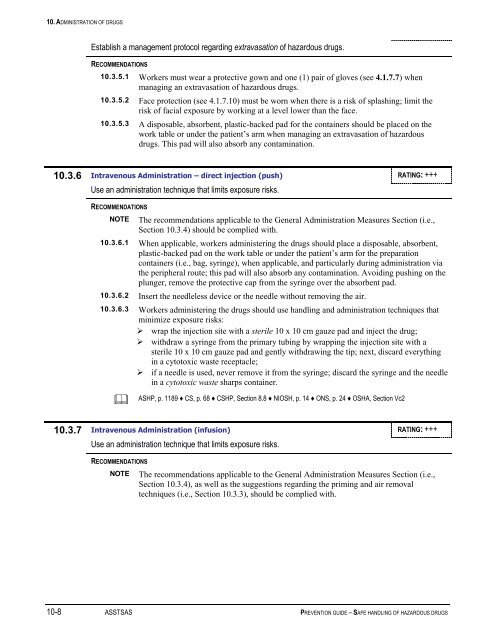Prevention Guide - Safe Handling of Hazardous Drugs - Irsst
Prevention Guide - Safe Handling of Hazardous Drugs - Irsst
Prevention Guide - Safe Handling of Hazardous Drugs - Irsst
Create successful ePaper yourself
Turn your PDF publications into a flip-book with our unique Google optimized e-Paper software.
10. ADMINISTRATION OF DRUGS<br />
Establish a management protocol regarding extravasation <strong>of</strong> hazardous drugs.<br />
RECOMMENDATIONS<br />
10.3.5.1 Workers must wear a protective gown and one (1) pair <strong>of</strong> gloves (see 4.1.7.7) when<br />
managing an extravasation <strong>of</strong> hazardous drugs.<br />
10.3.5.2 Face protection (see 4.1.7.10) must be worn when there is a risk <strong>of</strong> splashing; limit the<br />
risk <strong>of</strong> facial exposure by working at a level lower than the face.<br />
10.3.5.3 A disposable, absorbent, plastic-backed pad for the containers should be placed on the<br />
work table or under the patient’s arm when managing an extravasation <strong>of</strong> hazardous<br />
drugs. This pad will also absorb any contamination.<br />
10.3.6 Intravenous Administration – direct injection (push) RATING: +++<br />
Use an administration technique that limits exposure risks.<br />
RECOMMENDATIONS<br />
NOTE<br />
The recommendations applicable to the General Administration Measures Section (i.e.,<br />
Section 10.3.4) should be complied with.<br />
10.3.6.1 When applicable, workers administering the drugs should place a disposable, absorbent,<br />
plastic-backed pad on the work table or under the patient’s arm for the preparation<br />
containers (i.e., bag, syringe), when applicable, and particularly during administration via<br />
the peripheral route; this pad will also absorb any contamination. Avoiding pushing on the<br />
plunger, remove the protective cap from the syringe over the absorbent pad.<br />
10.3.6.2 Insert the needleless device or the needle without removing the air.<br />
10.3.6.3 Workers administering the drugs should use handling and administration techniques that<br />
minimize exposure risks:<br />
‣ wrap the injection site with a sterile 10 x 10 cm gauze pad and inject the drug;<br />
‣ withdraw a syringe from the primary tubing by wrapping the injection site with a<br />
sterile 10 x 10 cm gauze pad and gently withdrawing the tip; next, discard everything<br />
in a cytotoxic waste receptacle;<br />
‣ if a needle is used, never remove it from the syringe; discard the syringe and the needle<br />
in a cytotoxic waste sharps container.<br />
<br />
ASHP, p. 1189 ♦ CS, p. 68 ♦ CSHP, Section 8.8 ♦ NIOSH, p. 14 ♦ ONS, p. 24 ♦ OSHA, Section Vc2<br />
10.3.7 Intravenous Administration (infusion) RATING: +++<br />
Use an administration technique that limits exposure risks.<br />
RECOMMENDATIONS<br />
NOTE<br />
The recommendations applicable to the General Administration Measures Section (i.e.,<br />
Section 10.3.4), as well as the suggestions regarding the priming and air removal<br />
techniques (i.e., Section 10.3.3), should be complied with.<br />
10-8 ASSTSAS PREVENTION GUIDE – SAFE HANDLING OF HAZARDOUS DRUGS

















